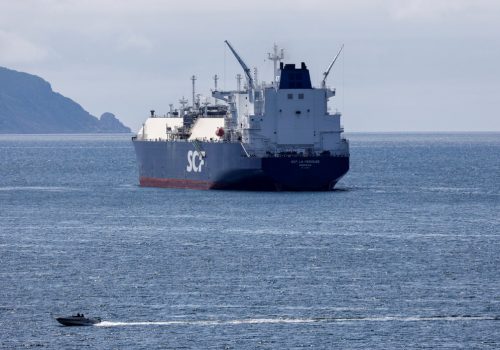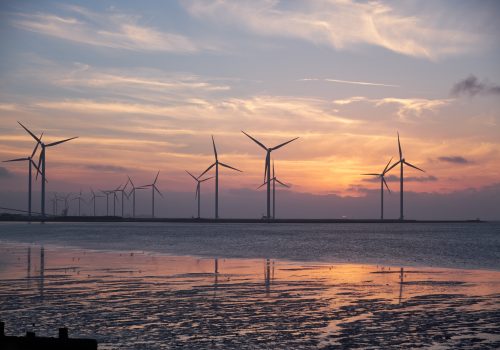Accelerating the energy transition to strengthen European energy security: Key barriers to overcome
More than one year on from Russia’s full-scale invasion of Ukraine, Europe must work diligently to prevent potential supply shortages ahead of a challenging winter, while embarking on a long-term transformation of its energy system to secure it against geopolitical volatility. Russia’s weaponization of fossil fuel exports demonstrates the security vulnerabilities inherent in a hydrocarbon-based economy and present an opportunity to accelerate Europe’s climate ambition while tying decarbonization inextricably to energy security fundamentals. By transitioning to a low-carbon economy, Europe can diversify its energy system and avoid dependence on foreign imports. By the same token, it must also build capacity in its clean energy value chain to avoid overreliance on China in a decarbonized future.
In this issue brief, Global Energy Center experts examine the role of decarbonization in European energy security, the obstacles impeding clean energy development, and the opportunities for transatlantic collaboration towards low-carbon energy security.
I. Introduction
More than one year on from Russia’s full-scale invasion of Ukraine, Europe has risen to the occasion to replace a majority of its Russian gas imports, reduce energy demand, and deploy clean energy in a remarkably short period of time. However, a more difficult winter looms on the horizon, as the global market for liquified natural gas tightens amid resurgent demand in East Asia. Uncertainty lingers as to whether Russia’s remaining exports will continue to flow and whether temperatures will remain mild. Europe must work diligently to prevent potential supply shortages while remaking its energy system to avoid reliance on Russia ever again.
This energy transformation presents an opportunity to accelerate Europe’s climate ambition while inextricably tying decarbonization to energy security fundamentals. As the events of the past year demonstrate, energy security is central to national security. Russia’s weaponization of fossil fuel exports demonstrates the security vulnerabilities inherent in a hydrocarbon-based economy. By transitioning to a low-carbon economy, Europe can diversify its energy system and negate the possibility of reverting to dependence on Russian fuels. By the same token, it must also build diversified capacity in its clean energy value chain to avoid overreliance on China in a decarbonized future.
Natural gas will continue to be important for Europe’s energy system and its energy transition, as the authors described in a previous issue brief, part of a larger project on reducing reliance on Russian energy sources.1Richard L. Morningstar, András Simonyi, Olga Khakova, and Paddy Ryan, “Securing alternative gas supplies and addressing critical infrastructure gaps in Europe,” EnergySource, December 8, 2022, https://www.atlanticcouncil.org/in-depth-research-reports/issue-brief/securing-alternative-gas-supplies-and-addressing-critical-infrastructure-gaps-in-europe/ This paper, part two of four in the project, examines how accelerating clean energy and increasing energy efficiency can defend Europe against Moscow’s weaponization of energy and ensure long-term security and affordability in line with climate targets. The paper also examines the United States’ impactful role in optimizing these efforts through transatlantic public-private cooperation on clean energy supply chains, financing, regulations, and standards.
Europe will remain a net-energy importer for the foreseeable future, but it can address a large portion of its gas supply insecurities by reducing import demand through localized clean energy generation, energy efficiency and other decarbonization measures. The EU demonstrated higher climate ambition with the updated renewables percentage target for 2030 in the Renewable Energy Directive, but targets alone are insufficient to drive faster deployment at the national level. Diversifying Europe’s energy mix while reforming the electricity market can lower prices, increase market stability, and maintain industrial competitiveness. This can insure Europe against backsliding toward Russian energy while also supporting European ambitions for climate neutrality by mid-century.
Decarbonizing electricity generation can be achieved relatively quickly compared to doing so for other energy systems. Already in 2022, wind and solar generated more electricity in Europe than gas for the first time. Notably, record solar generation of 203 terawatt-hours represented the equivalent of 35 billion cubic meters (bcm) of gas demand foregone last year.2Dave Jones, European Electricity Review 2023, Ember, January 31, 2023, https://ember-climate.org/insights/research/european-electricity-review-2023/ Increasing clean baseload generation and energy storage is still needed to balance renewables’ intermittent generation on the grid. More must be done to ensure that hydropower, batteries, geothermal, and nuclear—among others—are expanded and extended to ensure a clean, reliable, and secure power grid in Europe.
In addition to expanding clean energy, other decarbonization strategies will be needed to bolster energy security. Retrofitting buildings to improve energy efficiency can further reduce demand for electricity and heat, thereby reducing reliance on Russian gas. Further down the line, electrifying transport and integrating low-carbon fuels into heat-intensive industry can further cut demand for Russian energy. Building supply chains is also necessary to ensure that Europe does not again become reliant on a single supplier for clean technologies and critical raw materials.
A clear roadmap for low-carbon energy security in Europe has emerged. To proceed at a pace demanded by the current crisis, a number of roadblocks to the deployment of clean energy and energy efficiency must be addressed. Transatlantic cooperation could play a pivotal role in doing so.
II. Regulatory Reforms
Two separate varieties of regulation are holding back investments in clean energy: permitting and electricity market design. Regulatory reforms can reduce investment uncertainty to accelerate clean energy deployment across Europe.
In its current state, the permitting process creates a significant hurdle for increasing the stock of clean power generation, much like in the United States. In Europe, permitting an onshore wind facility can take as long as a decade.3Fixing Permitting for Renewables Deployment is an imperative”, Bellona Europa, April 12, 2022, https://bellona.org/news/eu/2022-04-fixing-permitting-for-renewables-deployment-is-an-imperative Regulatory uncertainty took a significant toll on the wind power sector in 2022. Despite being the single largest source of renewable electricity in the European Union, only sixteen gigawatts of new wind capacity were added in 2022, only a modest increase from 2021. Moreover, turbine orders fell 47 percent and no single offshore wind project reached final investment decision.4“The EU built only 16 GW new wind in 2022: must restore investor confidence and ramp up supply chain”, Wind Europe, February 28, 2023, https://windeurope.org/newsroom/press-releases/the-eu-built-only-16-gw-new-wind-in-2022-must-restore-investor-confidence-and-ramp-up-supply-chain/ Creating faster and more predictable permitting procedures can get more projects past the final investment decision phase.
The European Union is aware of the permitting roadblock and has acted swiftly to address it. The Commission’s REPowerEU plan—unveiled in May 2022 and approved by the European Council in December—introduces emergency permitting regulations that require onshore wind and solar project decisions be made within two years and shifts the burden of proof away from developers and toward public agencies. In addition, the plan deploys geospatial data to outline areas of low environmental risk; in these cases, the permitting process may be further shortened to a single year.5“Council agrees on accelerated permitting rules for renewables”, European Council, December 19, 2022, https://www.consilium.europa.eu/en/press/press-releases/2022/12/19/repowereu-council-agrees-on-accelerated-permitting-rules-for-renewables/ The proposed Net-Zero Industry Act would supercharge these efforts by further fast-tracking strategic clean energy technologies.
Europe’s emergency permitting measures are a good start, and offer a model for reform in places like the United States. More measures can add to this model’s success, including increasing staffing for permitting agencies—a perennial source of delay in the process—and broadening the scope of locally generated energy technologies relevant to the emergency measures.
Permitting is far from the only regulatory hurdle impeding clean energy deployment. Emergency measures at the EU state-level, including windfall levies, have created uncertainty for clean energy investments.Specific measures across member states compound the market distortion. Some member states have instituted different tax levels for different technologies, an arbitrary means for the state to pick winners and losers that can frighten investors. Other states have introduced levies that ignore the “profit” part of a windfall tax, often taxing the revenue of companies on long-term contracts that do not enjoy windfall-level profits.
Reforms at the European Union level are needed to create greater certainty in electricity markets. Efforts are underway in Brussels to restructure the electricity market to reflect the cost of production more accurately by removing gas as the de facto price benchmark. This change could remove the uncertainty created by price volatility and member states’ various consumer-support schemes, which introduced new taxes on clean energy producers, even though it could eliminate the large profits otherwise enjoyed by renewables producers prior to the imposition of the windfall levy, thereby potentially impacting investment capacity. To mitigate against this risk, EU member states will be able to offer long-term power purchase agreements and contracts for difference, which can spur investment through steady—if unspectacular—profit assurances, under the latest proposal. However, it will be important that these national-level support schemes do not distort the single market across Europe.
III. Public Financing
In addition to encouraging private investment, Europe must also boost public financing to achieve clean energy and energy efficiency objectives. Europe has a strong track record on energy subsidies and can build on that history to accelerate an energy-secure, decarbonized economy.
In 2020, EU and member state subsidies for renewables and energy efficiency totaled €95 billion, before falling slightly in 2021.62022 Report on Energy Subsidies in the EU, European Commission, November 15, 2022, https://eur-lex.europa.eu/legal-content/EN/TXT/PDF/?uri=CELEX:52022DC0642 Since then, the market environment has changed significantly with the introduction of the Inflation Reduction Act (IRA) in the United States, which provides $369 billion (€350 billion) in subsidies for clean industries by 2030. Although the intent of the IRA was not to threaten Europe’s green industries, its emphasis on onshoring the manufacturing of key clean energy technologies has invigorated trade tensions between the European Union and United States, as European leaders have raised concerns about investment flows moving across the Atlantic.
The European response to the US law—the Commission’s Net-Zero Industry Act, part of its Green Deal Industrial Plan—aims to marshal existing EU funding facilities toward producing 40 percent of EU cleantech demand within the bloc by 2030. The proposal does not include new funding to incentivize clean tech production, but instead leverages existing EU funding and relaxes state aid rules, which normally limit member-state subsidies to national industry to prevent distortion within the European Single Market. Additionally, the plan seeks to simplify project permitting and optimize approval for funding Important Projects of Common European Interest.
The state aid proposal may be the plan’s most contentious element. The capacity to finance industrial subsidies varies widely among EU member states, and the two largest member states—Germany and France—have accounted for nearly 80 percent of the European Commission’s state aid waivers since the rules were altered following Russia’s invasion of Ukraine.7Jorge Liboreiro, “Germany & France account for most EU subsidies. Here’s why it’s a concern”, Euronews, January 19, 2023, https://www.euronews.com/my-europe/2023/01/17/germany-france-account-for-most-eu-state-aid-heres-why-its-a-concern Italy, despite being Europe’s number two industrial economy, faces borrowing costs that are nearly 2 percent higher than Germany’s.8Industrial production statistics, Eurostat Statistics Explained, last updated August 2022, https://ec.europa.eu/eurostat/statistics-explained/index.php?title=Industrial_production_statistics#Industrial_production_by_country; Samuel Indyk and Stefano Rebaudo, “Euro zone yields edge down, still near multi-year highs”, Yahoo Finance, March 9, 2023, https://finance.yahoo.com/news/1-euro-zone-bond-yields-120756583.html?guce_referrer=aHR0cHM6Ly93d3cuZ29vZ2xlLmNvbS8&guce_referrer_sig=AQAAAJUgNKvNZbhXsqu40GdTmCAEn7bz5yEPnRTbcLX8q0zcRhUajFUfPsUbzWzIQnf790td522NMS_MYEFZS9xbZuuqArDw7DXKfqAzI4JcfkoGbOZghEOTafMJDt6L-8bLe3Vq2qDvPgQ6t9Jk5-8YfIYN8gS32B0oOphxC7np_FgX&guccounter=2 EU Internal Market Commissioner Thierry Breton has proposed EU loan guarantees as a way to level the playing field, but fiscally conservative member states have resisted.9Javier Espinoza and Andy Bounds, Brussels response to US green push falls short says top official, Financial Times, February 7, 2023, https://www.ft.com/content/6d3e0862-e2e3-4e78-b0b6-a6b549616f5b
EU member states must also consider the joint public investments needed to enable decarbonization. Aging interconnections and insufficient capacity are impediments to the private investment needed to create secure, decarbonized energy systems. Massive quantities of renewable energy generation await interconnection; in Poland alone, solar capacity of twenty gigawatts is idle waiting for permits to connect to the grid.10Harriet Fox, Ready, Set, Go, Europe’s race for wind and solar, Ember, July 27, 2022 https://ember-climate.org/insights/research/europes-race-for-wind-and-solar/ Beyond building out capacity, Europe must invest in new grid-management systems that can facilitate complex demand-response schemes and absorb generation from prosumers, which are households and businesses that contribute to energy supply with their own resources such as rooftop solar panels or batteries.
IV. Transatlantic Collaboration
The United States has a strategic interest in maintaining the cohesion of its allies to limit backsliding as the Russia-Ukraine war draws out. Also, to address climate change, the world needs to scale up clean industry in every jurisdiction possible. The United States thus has an interest in seeing its allies build up these industries in the same manner it aspires to under the IRA, and collaboration in these objectives can be of mutual benefit. By working productively with the EU and member states in support of Europe’s green industrial ambitions, Washington can help mend ties after the IRA and ensure that the law creates a “race to the top” on “friendshored” clean industry, rather than a transatlantic zero-sum game. Key to these efforts should be recognizing products from the other jurisdiction as friendshored under the respective legislation, as well as collaborating on upskilling workers for a low-carbon economy through partnerships on “Net Zero Academies.”
European states have the wherewithal to support industry and are supporting consumers through the current crisis. Member states have spent nearly €800 billion since the autumn of 2021 to subsidize energy bills. Redirecting that funding toward investments that can lower energy prices over the longer term can provide a more sustainable path toward energy-market normality. As gas prices fall, ending price-support subsidies and replacing them with subsidies for heat-pump installation or building retrofits can reduce the need for future emergency measures, particularly for politically sensitive users like industry.
While Europeans will bear the financial responsibilities for these measures, Washington can leverage the US private sector to great effect. The US Export-Import Bank should prioritize financing for exports to Europe of key technologies, like heat pumps, that the United States can provide cheaply and quickly to boost European supply. Ultimately, while the United States should respect Europe’s desire to grow its own on-shore clean industry, measures that focus on enabling a transatlantic cleantech trade will bring mutual benefit. Longer-term solutions should seek to enable an approach based on cooperation across the supply chain.
To enhance the energy security of its allies and turbocharge its global climate ambitions, the United States should collaborate with Europe on commercializing emerging technologies that can provide firm power to achieve a zero-carbon grid, including geothermal, carbon capture, advanced nuclear fission and fusion technologies, and many others. Such collaboration would be of mutual benefit, and by exchanging best practices both sides can find the right policy framework to bring new technologies to market at scale. For example, the European Commission’s announcement of a hydrogen bank that will connect consumers with producers offers a model for how to create the offtake necessary to commercialize new technologies.
Multilateral efforts exist to catalyze this exchange of technology and related policy, including the Three Seas Initiative, US-EU Energy Council, Mission Innovation, US-EU Trade and Technology Council and the Partnership for Transatlantic Energy Security and Climate Cooperation (P-TECC).
These multilateral forums can also facilitate the exchange of best practices on grid management and energy-efficiency standards. US National Laboratories can provide expertise and advise European governments on creating next-generation grid systems that can meet the demands created by electrification, intermittency, and cyber vulnerabilities. The United States and Europe can also strengthen cooperation on energy-efficiency investments by exchanging national and subnational best practices such as the United States’ standards-setting Energy Star program that signals to the private sector what to produce.
V. Clean Energy Supply Chain
Realizing a secure low-carbon European energy system requires a scaled-up and diversified supply chain for clean energy technologies. Already, supply chain bottlenecks are impeding the growth of renewable energy in Europe. In 2022, the European wind industry experienced cost increases of as much as 40 percent; contracts for wind power, however, have largely remained fixed, chilling investment.11Anna Flavia Rochas and Robin Sayles, “EU wind targets under threat from volatile costs”, Reuters, November 16, 2022, https://www.reutersevents.com/renewables/wind/eu-wind-targets-under-threat-volatile-costs
The price stability of raw materials is now a key constraint in clean-power deployment. Nickel, a vital metal for wind turbines and batteries, is heavily impacted by the war in Ukraine. In 2021, Russia accounted for 42 percent of EU nickel imports.12“Product groups with the highest share for Russia in EU imports”, Eurostat Statistics Explained, last updated April 5 2022, https://ec.europa.eu/eurostat/statistics-explained/index.php?title=File:Product_groups_with_the_highest_share_for_Russia_in_EU_imports,_2021.png In 2021, Russia supplied 17 percent of EU copper imports, a metal central to electrification, among other applications.13“Product groups for Russia in EU imports”
Additionally, through its grip on uranium supplies, Russia also looms large in Europe’s nuclear energy sector. Russia supplies 20 percent of the uranium imports that power Europe’s nuclear reactors, the bloc’s largest source of carbon-free power, which are responsible for a quarter of the bloc’s electricity.14“Euratom Supply Agency Annual Report 2021”, Euratom, August 10, 2022, https://euratom-supply.ec.europa.eu/publications/esa-annual-reports_en Russia also has a monopoly over global commercial sales of high-assay low-enriched uranium (HALEU) needed for advanced reactors. New nuclear fuel supply chains are needed, and if the United States, Canada, and other like-minded partners are able to move forward rapidly on plans to deploy small modular reactors in Europe, advanced nuclear could weaken Rosatom’s influence over nuclear operations, despite the Russian state-controlled company’s plans to deploy small modular reactors domestically.
Russia’s central role in the nuclear supply chain has shielded Rosatom from international sanctions. A bid to introduce sanctions on the company at the one-year anniversary of the war failed to gain traction in the European Council.15Leonie Kijewski and Jacobo Barigazzi, “EU Commission scratches Russia nuclear sanction plans”, Politico, February 16, 2023, https://www.politico.eu/article/rosatom-russia-ukraine-volodymyr-zelenskyy-vladimir-putin-eu-executive-scratches-russia-nuclear-sanctions-plans/ Rosatom operates eighteen reactors in the European Union, and has a monopoly on nuclear power in five EU member states. Two more Rosatom reactors are being constructed in Hungary, and an additional two are about to come online in Slovakia.16Tae-Yoon Kim, “Critical minerals threaten a decades-long trend of cost declines for clean energy technologies”, IEA, May 18, 2022, https://www.iea.org/data-and-statistics/charts/share-of-global-production-and-rank-for-selected-minerals-and-metals-in-russia-2020 Implementing enduring sanctions and providing long-term offtake agreements with alternative nuclear fuel suppliers can give investors the confidence to devote resources to this sector.
In addition, Russia enjoys a commanding position in the supply chain for more emergent clean technologies. In palladium and platinum, key components for hydrogen fuel cells, Russia accounted for 43 and 14 percent of global production, respectively.17Tae-Yoon Kim, “Critical minerals threaten a decades-long trend of cost declines for clean energy technologies”, IEA, May 18, 2022, https://www.iea.org/data-and-statistics/charts/share-of-global-production-and-rank-for-selected-minerals-and-metals-in-russia-2020 Russia could thus still play a pivotal role in the hardware for a European hydrogen economy, presenting a critical political risk that must be urgently addressed.
Europe’s divorce from Russian hydrocarbons must not merely swap a fuels dependency for a metals one. Nor should Europe swap one monopolistic supplier for another; where Russia does not dominate the European clean-technology metal supply chain, China has an even more formidable grip.
China controls most of the global midstream refining capacity of important clean-technology metals. It supplies the European Union with 47 percent of its natural graphite and 93 percent of its magnesium—both critical to battery technologies—as well as 98 percent of the rare earths elements that are used in permanent magnets for wind turbines and electric vehicle motors.18Critical Raw Materials, European Commission, https://single-market-economy.ec.europa.eu/sectors/raw-materials/areas-specific-interest/critical-raw-materials_en Further along the supply chain, China accounted for 95 percent of Europe’s solar imports, and Europe’s own solar industry relies on chips and other inputs originating from China.19Margherita Stancati, “Europe’s Next Energy Test: Wrestling Solar Back From China”, The Wall Street Journal, February 10, 2023, https://www.wsj.com/articles/europes-next-energy-test-wrestling-solar-back-from-china-e5c62e2e
Europe faces a significant dilemma. To reduce its demand for Russian energy, it must deploy cleantech as quickly as possible. At the same time, it must avoid becoming overly reliant on a single supplier that can provide these technologies—and the raw materials underlying them—at low cost and with high capacity. In other words, Europe needs China in the short term in order to limit the inflationary consequences of disengaging with existing market incumbents, but must build out its clean energy supply chain to reduce its reliance on China in the longer term. As European policymakers like Commission President Ursula von der Leyen have rightly noted, decoupling from China is not a realistic policy, but de-risking Europe’s economic relations with the country is a necessity.
Europe must be aware of the longer-term risks and act to mitigate them. A forthcoming Critical Raw Materials Act provides a starting point to remedy this situation. The act will aim to increase and diversify the supply of metals needed for the EU’s green and digital transformations by identifying new resources and projects inside and outside the EU. The plan sets a requirement that 10 percent of EU consumption of strategic raw materials be mined within the bloc and that 40 percent be processed within the EU.20Oliver Noyan, “EU Commission wants 10% of critical raw minerals mined in Europe”, Euractiv, March 7, 2023, https://www.euractiv.com/section/economy-jobs/news/leak-eu-commission-wants-10-of-critical-raw-materials-mined-in-europe/
On-shoring of strategic portions of the value chain in Europe, the United States, and other like-minded partners is important for energy security, setting standards on sustainable resource governance, and maximizing the economic benefits of localization for heavy and difficult-to-transport cleantech assets like batteries. However, that does not preclude cooperation on strategic supply chain issues.
The March 2023 agreement between Presidents Joe Biden and Ursula von der Leyen to explore allowing EU-produced minerals to qualify for IRA tax credits through a US-EU trade deal on clean-technology metals provides a valuable starting point for aligning transatlantic supply chains to emerge, where possible, and spur investments in both jurisdictions.21Jeff Mason, Steve Holland, and Andrea Shalal, United States, “EU agree to start talks on critical minerals amid trade emissions”, Reuters, March 10, 2023, https://www.reuters.com/markets/commodities/amid-trade-dispute-us-eu-seek-minerals-agreement-talks-subsidies-2023-03-10/ The United States’ own efforts under the IRA and the previous Infrastructure Investment and Jobs Act to subsidize US-managed critical supply chains provide another boost to transatlantic trade in raw materials. Additionally, transatlantic cooperation on critical minerals will be vital to the EU’s goal to phase out the sale of new petrol and diesel cars starting in 2035.
By cooperating through multilateral initiatives like the US-led Minerals Security Partnership and Environmental Resource Governance Initiative (ERGI), the United States and Europe can work together to disseminate best practices in the sector and help partners in the developing world grow their own strategic mineral industries in alignment with these standards, diversifying the global marketplace and building the resource capacity needed to support global decarbonization efforts. By integrating these partnerships with investment initiatives like the European Union’s Global Gateway and the Group of Seven’s (G7) Build Back Better World, the United States and European partners can work to catalyze investment in clean energy resources across the world and outcompete China as it seeks to accumulate raw materials without regard for environmental and labor standards.
Post-war Ukraine can be an important source of metals to power Europe’s clean energy industry. Ukraine is the world’s sixth-largest producer of graphite, and with one of the world’s largest supplies of graphite reserves, Kyiv could increase output and chip away at China’s market dominance in Europe. Ukraine also has significant reserves of copper, lithium, and cobalt, which could be of strategic importance for Europe after the war.22Anthony Barich, “Metals and the invasion: Ukraine aims for critical minerals after the war”, S&P Global, February 21, 2023, https://www.spglobal.com/marketintelligence/en/news-insights/latest-news-headlines/metals-and-the-invasion-ukraine-aims-for-critical-minerals-after-the-war-74205684; Anthony Barich, “Ukraine aims to become major graphite supplier, when the war ends”, S&P Global, May 10, 2023, https://www.spglobal.com/marketintelligence/en/news-insights/latest-news-headlines/ukraine-aims-to-become-major-graphite-supplier-8212-when-the-war-ends-70113612 Looking ahead, Ukraine can be a critical player in Europe’s drive for decarbonized energy security, and this topic will be the subject of our third and final issue brief in this series.
V. Conclusion
To realize low-carbon energy security in Europe, policymakers must remove the roadblocks curtailing rapid deployment of clean energy. Chief among those roadblocks are the regulatory hurdles that slow down permitting and investment, market structures that discourage private capital investments in clean energy, and complications with the clean energy supply chain that make projects too costly. For each obstacle, the United States can play a positive supporting role in removing barriers and ensuring a speedy rollout of clean energy to stiffen its allies’ resolve against Russian aggression.
Europe needs to streamline and clarify its regulations to encourage investment in its clean energy sector. By streamlining rules and building capacity for quicker permitting, projects can be built in a timelier manner, and investors from the continent and beyond can proceed with greater clarity. Implementing market reforms at the European level can likewise create greater certainty for business and prevent the distortions created by unilateral member-state actions.
In tandem with Europe’s efforts, Washington can play a more significant role in catalyzing financing for projects on the continent, including through the Export-Import bank’s ability to steer the US private sector toward areas of significant strategic need in the European energy system. Such moves will help coalesce a common European green industrial strategy.
Transatlantic partnership to build capacity, resilience, and sustainability in the clean-technology supply chain can weaken adversaries’ control of the resources needed to achieve low-carbon energy security. By working at a global scale to set standards for resource governance and tie these standards to investments in clean energy metals and processing, the United States and Europe can diversify the market for these strategic commodities and ensure that supply chain complications do not provide an obstacle to energy security and decarbonization efforts.
Europe and the United States have a unique opportunity to work together amid a hydrocarbon supply crisis to build the foundations for a cleaner and more secure energy system to combat the specters of both climate impact and energy market volatility. To combat climate change and the threats of malign actors looking to bend the geopolitics of energy to their own ends, it is vital that partners on both sides of the Atlantic seize this opportunity with both hands.
Authors
ACKNOWLEDGEMENTS
The Atlantic Council would like to thank our donor, the Smith Richardson Foundation, for supporting our work on this project.
This issue brief was written and published in accordance with the Atlantic Council Policy on intellectual independence. The authors are solely responsible for its analysis and recommendations. The Atlantic Council and its donors do not determine, nor do they necessarily endorse or advocate for, any of this issue brief’s conclusions.
The authors would like to thank Jonathan Joyner and Maxwell Zandi for their assistance with this project.
related content
stay connected
Subscribe to our newsletter
Sign up to receive our weekly DirectCurrent newsletter to stay up to date on the program’s work.

The Global Energy Center develops and promotes pragmatic and nonpartisan policy solutions designed to advance global energy security, enhance economic opportunity, and accelerate pathways to net-zero emissions.





